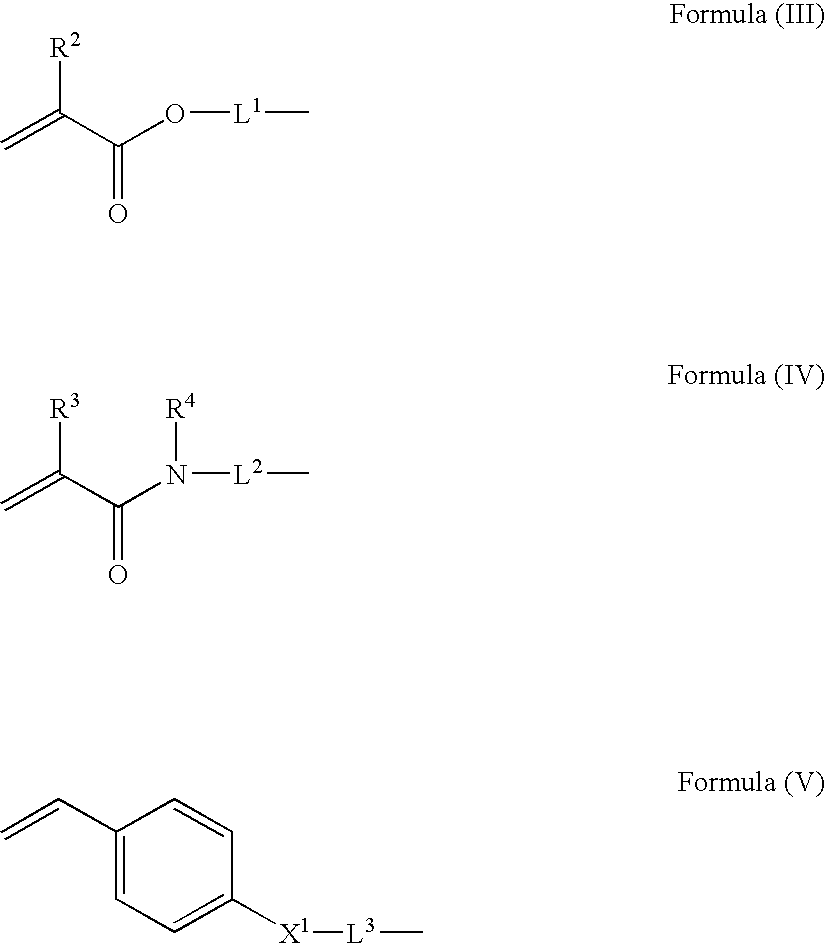Isocyanate composition, microcapsule and production method thereof, and recording material
- Summary
- Abstract
- Description
- Claims
- Application Information
AI Technical Summary
Benefits of technology
Problems solved by technology
Method used
Image
Examples
synthetic example 1
[0162] 18.8 parts of exemplified compound 1-1, compound represented by Formula (I), was dissolved in 18 parts of ethyl acetate. 0.105 parts of 2-mercaptoethanol was added to the resultant solution. Polymerization was carried out in the presence of 0.04 parts of 2,2′-azobis(2,4-dimethylvaleronitrile) (V-65™ manufactured by Wako Pure Chemical Industries, Ltd.,), serving as a polymerization initiator, in a surrounding temperature of 70° C. for 7 hours under nitrogen flow. After the completion of the polymerization, the resultant polymer solution was added to 300 parts of hexane to precipitate a product. As a result, 17.5 parts of exemplified polymer 2-1 was produced by radical polymerization of the above-mentioned compound 1-1 (yield: 93%).
synthetic example 2
[0163] 18.8 parts of exemplified compound 1-1, compound represented by Formula (I), and 5 parts of N-ethylacrylamide were dissolved in 20 parts of ethyl acetate. 0.105 parts of 2-mercaptoethanol was added to the resultant solution. Polymerization was carried out in the presence of 0.04 parts of 2,2′-azobis(2,4-dimethylvaleronitrile) (V-65™ manufactured by Wako Pure Chemical Industries, Ltd.,) serving as a polymerization initiator at a surrounding temperature of 70° C. for 7 hours under nitrogen flow. After the completion of the polymerization, the resultant polymer solution was added to 300 parts of hexane to precipitate a product. As a result, 22.3 parts of exemplified polymer 2-15 was produced by radical polymerization of the above-mentioned compound 1-1 and N-ethylacrylamide (yield: 94%).
synthetic example 3
[0164] 17.2 parts of exemplified compound 1-1, compound represented by Formula (I), and 4 parts of N-ethylacrylamide were dissolved in 20 parts of ethyl acetate. 0.102 parts of 2-mercaptoethanol was added to the resultant solution. Polymerization was carried out in the presence of 0.035 parts of 2,2′-azobis(2,4-dimethylvaleronitrile) (V-65™ manufactured by Wako Pure Chemical Industries, Ltd.,) serving as a polymerization initiator at a surrounding temperature of 70° C. for 7 hours under nitrogen flow. After the completion of the polymerization, the resultant polymer solution was added to 300 parts of hexane to precipitate a product. As a result, 20.1 parts of exemplified polymer 2-16 was produced by radical polymerization of the above-mentioned compound 1-1 and N-ethylacrylamide (yield: 95%).
PUM
| Property | Measurement | Unit |
|---|---|---|
| Mass | aaaaa | aaaaa |
| Composition | aaaaa | aaaaa |
| Thermosensitivity | aaaaa | aaaaa |
Abstract
Description
Claims
Application Information
 Login to View More
Login to View More - R&D
- Intellectual Property
- Life Sciences
- Materials
- Tech Scout
- Unparalleled Data Quality
- Higher Quality Content
- 60% Fewer Hallucinations
Browse by: Latest US Patents, China's latest patents, Technical Efficacy Thesaurus, Application Domain, Technology Topic, Popular Technical Reports.
© 2025 PatSnap. All rights reserved.Legal|Privacy policy|Modern Slavery Act Transparency Statement|Sitemap|About US| Contact US: help@patsnap.com



